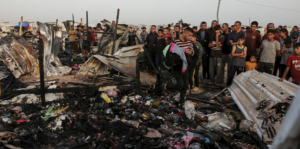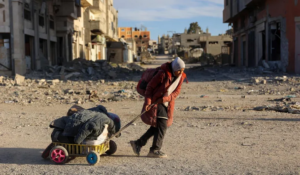A soldier’s warning: What I saw in Gaza will define our future

Palestinians look at the destruction after an Israeli strike where displaced people were staying in Rafah, Gaza Strip, 27 May 2024
An anonymous soldier writes in Haaretz on 28 November 2024:
The truly surprising thing is the quickness with which everything looks normal and reasonable. After a few hours, you find yourself trying hard to be impressed by the magnitude of the destruction, muttering to yourself sentences like “This is madness,” but the truth is that you get used to it pretty quickly.
It becomes banal, kitschy. Another heap of stones. Here was probably a building of an official institution, those were homes and this area was a neighborhood. In any direction you look, you see piles of rebar, sand, concrete and cinderblocks. Empty plastic water bottles and dust. All the way to the horizon. To the sea. The eye moves along to a building that is still standing. “Why haven’t they taken down this building?” my sister asks on WhatsApp after I sent her a picture. “And also,” she added, “why the hell did you go there?”
Why I’m here is less of interest. I’m not the story here. And this is also not an indictment against the Israel Defense Forces. That has a place elsewhere, in editorials, in the International Criminal Court in The Hague, at universities in the United States, at the UN Security Council.
The important thing is to reflect what is happening for the Israeli public. To bring things to the surface. So people won’t say afterward that they didn’t know. I wanted to know what was happening here. That’s what I told all my friends, too many of them to count, who asked me, “Why did you go into Gaza?”
There isn’t much to say about the destruction. It’s everywhere. It jumps into view when you get closer to what used be a residential neighborhood from the vantage point of a drone: a cultivated garden surrounded by a broken wall and a pulverized house. An improvised shack with a tin roof down an alley. Dark patches in the sand, one next to another: Apparently there was some kind of grove there. Maybe an olive grove. Now is olive harvest season. And there’s some movement – a person climbing on a pile of rubble, gathering wood on a sidewalk, crushing something with a stone. All of it seen from a drone’s flight path.
The closer you get to logistical routes – Netzarim, Kissufim, Philadelphi – a fewer structures are still standing. The destruction is enormous, and it’s here to stay. And this is what people need to know: This thing will not be erased in the next 100 years. No matter how hard Israel tries to make it disappear, to blur it, the destruction in Gaza will define our lives and our children’s lives from now on. It’s testimony of unbridled rampaging. A friend wrote on the wall of the operations room: “Quiet will be answered by quiet, Nova will be answered by Nakba.” The army commanders have adopted this graffiti.
To a military eye, the destruction is inevitable. Fighting a well-equipped enemy in a densely populated urban area means destruction of buildings on a massive scale – or certain death for soldiers. If a brigade commander had to choose between the lives of the soldiers under his command or flattening the territory, an F-15 laden with bombs would already be heading down the runway at Nevatim Air Base and an artillery battery would be lining up the sights. No one is going to take risks. This is war.
Israel can fight like this thanks to the flow of weaponry it’s receiving from the United States, and the need to control the territory through minimal manpower is stretched to the limit. This is true of both Gaza and Lebanon. The main difference between Lebanon and the yellow hell around us is the civilians. In contrast to the villages of southern Lebanon, the civilians are still here. Dragging themselves from one nexus of fighting to another, lugging overloaded backpacks, jerricans. Mothers with children trudging along the road. If we have any water, we give it to them. The IDF’s technological capabilities have developed impressively in this war. The firepower, the precision, the collection of intelligence by drones: These provide a counterweight to the underworlds that Hamas and Hezbollah built over many years.

Dragging a few possessions along an unmade road – northern Gaza, November 2024
You find yourself gazing for hours from a distance at a civilian dragging a suitcase for a few kilometers on Salah al-Din Road. The blazing sun beats down on him. And you try to understand: Is it an explosive device? Is it what’s left of his life? You watch people milling around near the tent compound in the middle of the camp, look for explosive devices and stare at drawings on the wall in gray shades of charcoal. Here, for example, is a picture of a butterfly.
This week I did drone surveillance of a refugee camp. I watched two women walking hand in hand. A young guy who went into a half-destroyed house, and disappeared. Maybe he’s a Hamas operative and came to deliver a message through a hidden entrance to a tunnel where hostages are being held? From a height of 250 meters (820 feet), I followed someone riding a bike along what had once been a road at the edge of the neighborhood – an afternoon outing in the midst of a catastrophe. At one of the intersections, the cyclist stopped near a house from which a few children emerged, and then he continued into the depths of the refugee camp itself.
All the roofs have holes in them from the bombardments. On all of them are blue barrels for collecting rainwater. If you see a barrel on the road, you have to notify the control center, and mark it as a possible explosive device. Here is a man baking pitas. Next to him is a man sleeping on a mattress. By force of what inertia does life go on? How can a person wake up in the midst of horror like this and find the strength to get up, find food, try to survive? What future is the world offering him? Heat, flies, stench, dirty water. Another day goes by.
I’m waiting for the writer who will come and write about this, a photographer who will document it, but there’s only me. Other fighters, if they have any heretical thoughts, are keeping them to themselves. We aren’t talking about politicians because they asked, but the truth is that it simply doesn’t interest anyone who’s done 200 days of reserve duty this year. The reserves are collapsing. Anyone who shows up is already indifferent, bothered by personal problems or by other matters. Children, layoffs, studies, spouses. They fired the defense minister. Einav Zangauker, whose son Matan is held hostage somewhere here. The schnitzel sandwiches have arrived.
The only ones who get excited about anything are the animals. The dogs, the dogs. Wagging tails, running in huge packs, playing with one another. Chasing down scraps of food that the army has left behind. Here and there they dare to approach vehicles in the dark, try to drag away a box with kabanos sausages and are chased away by a cacophony of shouts. There are also many puppies.
Over the past two weeks the Israeli left wing has been worried about the army digging in on the east-west routes of the Gaza Strip. The Netzarim route, for example. What hasn’t been said about it? That it’s being paved, that there are five-star bases on it. That the IDF is there to stay, that on the basis of this infrastructure the settlement project in the Strip will rise again.
I don’t dismiss these concerns. There are enough crazy people who are just waiting for the opportunity. But the Netzarim and Kissufim routes are combat zones, areas between huge concentrations of Palestinians. A critical mass of despair, hunger and distress. This is not the West Bank. The entrenchment along the route is tactical. More than to ensure a civilian hold on the territory, it’s designed to provide security for worn-out soldiers. The bases and the outposts consist of portable structures that can be dismantled and removed on a convoy of trucks within a few days. Of course this could change.
To all of us, from those in the control room to the last of the fighters, it’s clear that the government doesn’t know a damn thing about how to proceed from here. There are no goals to advance to, no political ability to retreat. Except for in Jabalya, there’s hardly any fighting. Only at the edges of the camps. And even this is partial, for fear that hostages might be there. The problem is diplomatic, not military and not tactical. And therefore it’s clear to everyone that we will be called up for yet another round, for the exact same missions. Reservists will still come, but fewer of them.
Where’s the line between understanding the “complexity” and blind obedience? When have you earned the right to refuse to take part in a war crime? That’s less of interest. What’s more of interest is when will the Israeli mainstream wake up, when will a leader arise who’ll explain to the citizens what a terrible mess we’re in, and who will be the first kippah-wearer to call me a traitor. Because before The Hague, before the American universities, before the condemnation in the Security Council, this is first and foremost an internal matter for us. And for 2 million Palestinians.
The writer is a combat soldier in the reserves who has taken part in the ground operations in Lebanon and in the Gaza Strip over the past year.
This article is reproduced in its entirety
